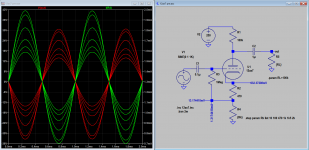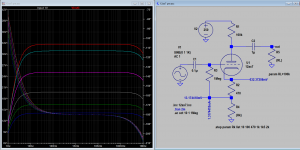Hello.
If I use an ecc83, I want it to amplify less than mu, I can't load it too much because it will skew the waveform.
I can't also limit the mA because it will cold bias it, and shift the waveform too.
so what can I do if I don't need all the gain (noise) ?
Thank you.
If I use an ecc83, I want it to amplify less than mu, I can't load it too much because it will skew the waveform.
I can't also limit the mA because it will cold bias it, and shift the waveform too.
so what can I do if I don't need all the gain (noise) ?
Thank you.
If it is just a single stage, you can change the anode resistor, lower Ra gives lower output with a given input.
If you can't lower Ra due to other factors unknown to us, split it up into two resistors (for the DC setting) and shunt one R with a C to set the AC gain.
But you gave very little info, my guess is that if you give more info on the use case someone can give you an obvious simple solution.
Most probably you worry about mu unnecessary. But you need to lay it all out!
Jan
If you can't lower Ra due to other factors unknown to us, split it up into two resistors (for the DC setting) and shunt one R with a C to set the AC gain.
But you gave very little info, my guess is that if you give more info on the use case someone can give you an obvious simple solution.
Most probably you worry about mu unnecessary. But you need to lay it all out!
Jan
When using resistors as load, the amplification/voltage gain is always less than μ.
If you look on page 3 of this datasheet for the ECC83 you will see that the voltage gain (Vo/Vi) gets lower when Ra (= plate load resistor) gets lower and/or when Vb gets lower.
Note that the value of Rg' (the grid resistor of the next stage) also has influence because for ac signal this resistor is in parallel with the plate resistor. It's good practice to choose the value of Rg' atleast three times higher than Ra.
The numbers for gain (Vo/Vi) are valid with the cathode resistor being bypassed by a capacitor of 50 uF. When this capacitor is omitted local negative feedback will be introduced, making the numers for voltage gain (Vo/Vi) lower.
The distortion is almost proportional to Vo. So if you would have a section of an ECC83 working with Ra = 100K, Rk = 1000 and Vb = 350 V, the distortion at Vo = 3.6 Vrms would be about 2.2/10 = 0.22 %.
If you look on page 3 of this datasheet for the ECC83 you will see that the voltage gain (Vo/Vi) gets lower when Ra (= plate load resistor) gets lower and/or when Vb gets lower.
Note that the value of Rg' (the grid resistor of the next stage) also has influence because for ac signal this resistor is in parallel with the plate resistor. It's good practice to choose the value of Rg' atleast three times higher than Ra.
The numbers for gain (Vo/Vi) are valid with the cathode resistor being bypassed by a capacitor of 50 uF. When this capacitor is omitted local negative feedback will be introduced, making the numers for voltage gain (Vo/Vi) lower.
The distortion is almost proportional to Vo. So if you would have a section of an ECC83 working with Ra = 100K, Rk = 1000 and Vb = 350 V, the distortion at Vo = 3.6 Vrms would be about 2.2/10 = 0.22 %.
Attachments
We are spoiled by easy to design SS circuits and ultra easy and flexible Op Amps 😉 ; tubes are not that flexible.
Each tube and configuration will provide a certain basic gain, which can be somewhat tweaked one way or another, but not much, certainly by the wide amount molten sand offers, so a common workaround is to let it amplify what it wants and passively attenuate extra gain.
I am into MI amplification, and very high gain Guitar amps always have 1 or 2 "excessive" gain stages since gain "comes in fixed amounts", and incorporate lots of attenuators along the signal path to finely tweak each one.
I guess your interest is Hi Fi but in any case, that is the way this tool works, if worried by hiss you can drop output signal + hiss using an attenuator.
Price paid is reduced headroom because attenuator also reduces peak available voltage but in Tube circuits that is usualynot a big problem.
Yes, you can also use NFB to fine tweak gain, but in that case it takes typically at least 2 gain stages cascaded so you have enough "surplus" gain to "throw away", also for gain stage to fit better what NFB net demands.
Each tube and configuration will provide a certain basic gain, which can be somewhat tweaked one way or another, but not much, certainly by the wide amount molten sand offers, so a common workaround is to let it amplify what it wants and passively attenuate extra gain.
I am into MI amplification, and very high gain Guitar amps always have 1 or 2 "excessive" gain stages since gain "comes in fixed amounts", and incorporate lots of attenuators along the signal path to finely tweak each one.
I guess your interest is Hi Fi but in any case, that is the way this tool works, if worried by hiss you can drop output signal + hiss using an attenuator.
Price paid is reduced headroom because attenuator also reduces peak available voltage but in Tube circuits that is usualynot a big problem.
Yes, you can also use NFB to fine tweak gain, but in that case it takes typically at least 2 gain stages cascaded so you have enough "surplus" gain to "throw away", also for gain stage to fit better what NFB net demands.
Local NFB. I'm kind of a Johnny One-Note on this but Frank Blöhbaum's MTA is under-tried and thus under-appreciated IMO. For that matter so is Rod Coleman's S. Cascode.
It really depends on how much you want to tailor the circuit to your output gain requirements. Just the 12AX7 with gain limited or the 12AX7 as part of a larger circuit with net output lower than the individual tube's ?
It really depends on how much you want to tailor the circuit to your output gain requirements. Just the 12AX7 with gain limited or the 12AX7 as part of a larger circuit with net output lower than the individual tube's ?
Potential divider
Some handy tables...
https://goldpt.com/bal_amps.html
https://goldpt.com/preattenuation.html
- Home
- Amplifiers
- Tubes / Valves
- By what mechanism do I limit the tube amplification factor ?

